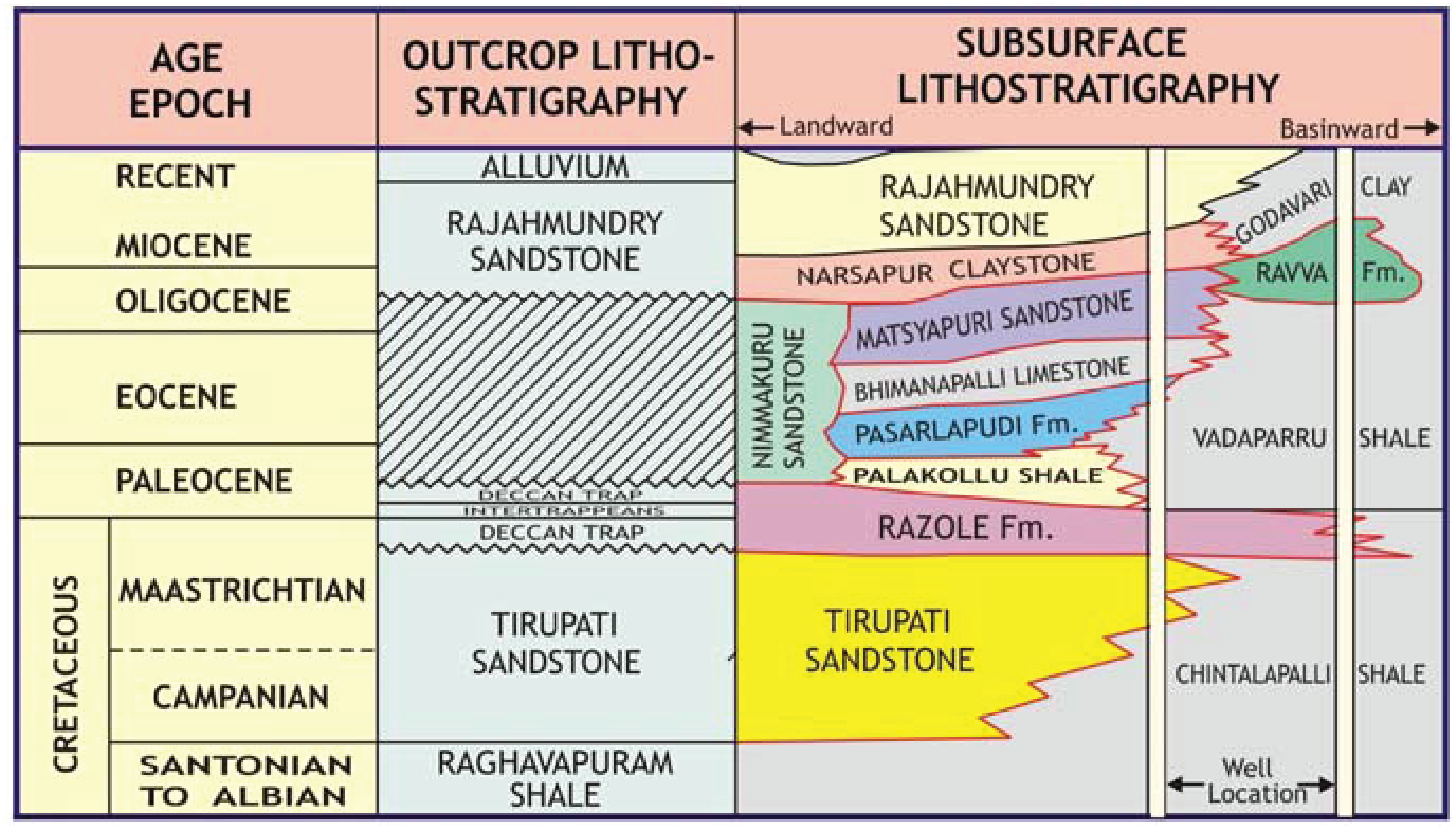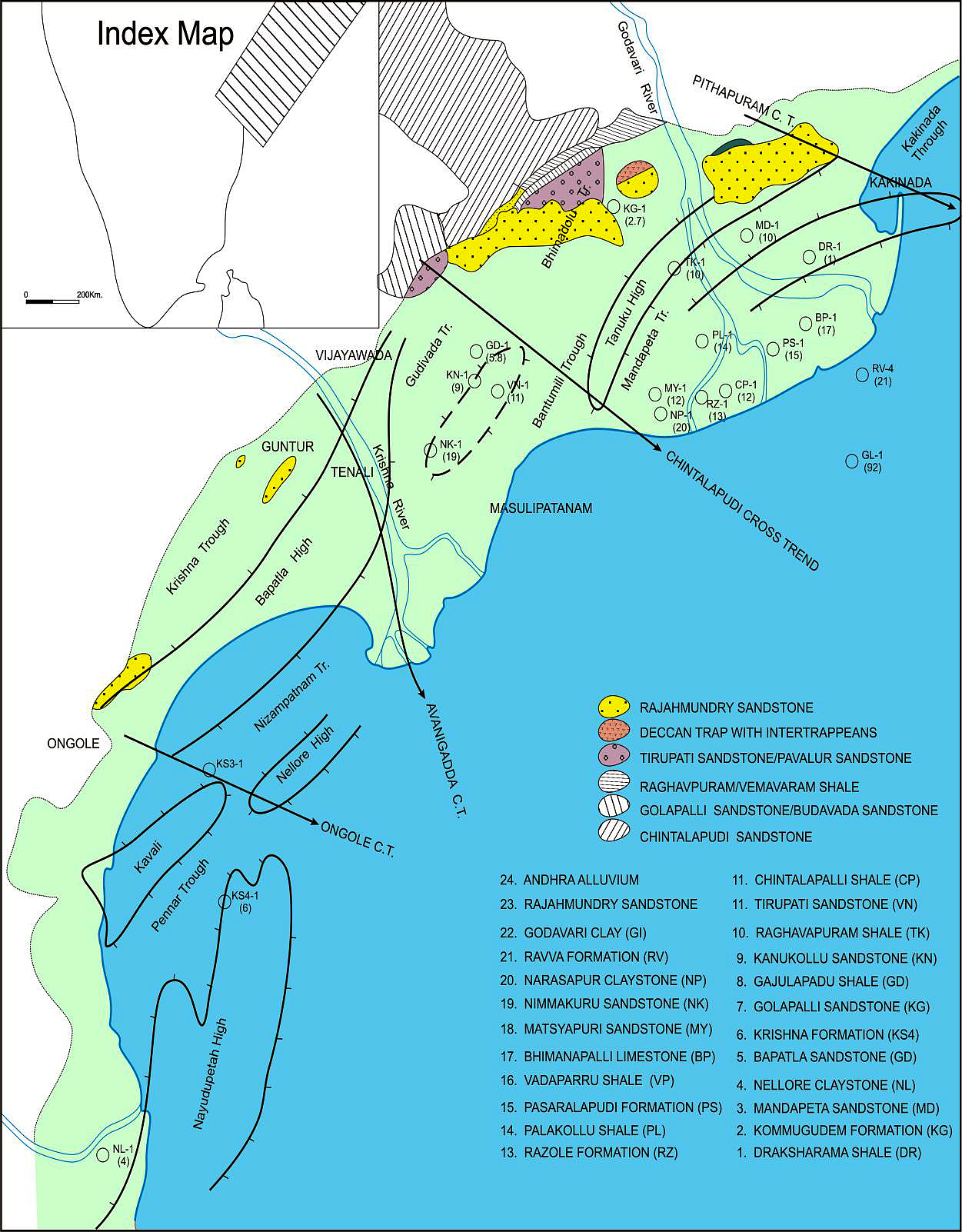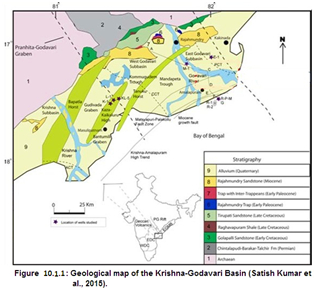Rajahmundry Fm
Type Locality and Naming
LANDWARD: Named after the Rajahmundry town. Type section is in the Outcrops near Rajahmundry town. [Original Publication: King, W. (1870) The Upper Gondwanas and other formations of the coastal region of the Godavari district. Mem. Geol. Suv. Ind, Vol. 16, pt-13, pp.]. This is the only "outcrop" unit; all other Krishna-Godavari formations are subsurface. Reference well: Well Draksharama-A (DR-A), Interval 0-635 m and thickness is 635 m.
Synonyms: Rajahmundry Sandstone
[Figure: Generalized Late Cretaceous-Cenozoic lithostratigraphy transect, Krishna-Godavari Basin. From Keller et al., 2011, Jour. Geol. Soc. India, 78:399-428, their Fig. 2]
[Figure: Map showing the locations of designated holostratotype section for the formation in the KG Basin (After ONGC, Pandey and Dave, 1998) in Raju et al., 2021, ONGC Bulletin, Special Issue, Vol. 56, No. 2]
Lithology and Thickness
Sandstone. In the type area, it consists of white to pale pinkish-white, friable sandstones. These are current-bedded, coarse- to medium-grained, clayey at places and lateritized towards the top. In the well Draksharama-A, the Rajahmundry Sandstone mainly comprises of sandstone with few light grey carbonaceous, silty clay beds. The sandstone is white to milky white, light yellow, fine to very coarse grained with granules and pebbles, ill sorted, subangular to subrounded. Reddish clay and laterite are seen at places. The total thickness of the exposed type section is about 250 m. In the drilled wells, the thickness of the Rajahmundry Sandstone varies from 240 m to 1090 m.
MEMBERS - sub divisions of Rajahmundry Formation (After Rao and Raju, 1969). (strat order):
iii) Dowleswaram Sandstone (7.5 m) – Uppermost member is medium brown to yellow, hard ferruginous sandstones which are thick-bedded. The whole sequence presents excellent cross- bedding.
ii) Pidimgoyya Sandstone (229 m) and Bommuru Claystone (9 m) -- Each unit forms a long lenticular bed intertonguing between the two major lithologies. The sandstones are profusely cross-bedded with thin claystone laminae interbedded with sandstone layers, both together constituting the fore sets of the cross-bedded unit. In addition, asymmetrical ripple marks and mud cracks are observed in this member. The sandstones are indurated with occasional dark ferruginous shales and clay pockets. A carbonaceous clay and lignite horizon is now recognized in the middle member (Rao and Raju, 1968).
i) Rajahmundry conglomerate and sandstone (30 m); underlain by Upper Trap basalt -- The basal member is conglomerate that changes into a sandstone facies 6.4 km NE of Rajahmundry. Lenses of clay and sand are common within the conglomerate. The bedding planes underneath the lenses show slight deformation. Both the sandstone as well as the conglomerate are profusely cross-bedded.
[Figure 1: Geological map of the Krishna Godavari Basin showing the Outcrops of Rajahmundry Fm (after Satish Kumar et al., 2015)]
Relationships and Distribution
Lower contact
Unconformably overlies Mimmakuru Fm sandstone or locally Matsyapuri Fm sandstone; or the Upper Trap basalt.
Upper contact
Unconformably overlain by Godavari Fm Clay; although this might be interfingering relationship, because some articles indicate that Godavari is more basinal whereas Rajahmundry Fm is more landward.
GeoJSON
Fossils
Rare Palynofossils.
Age
Depositional setting
Continental to marginal marine
Additional Information


